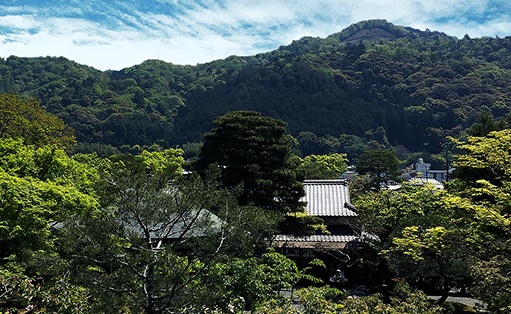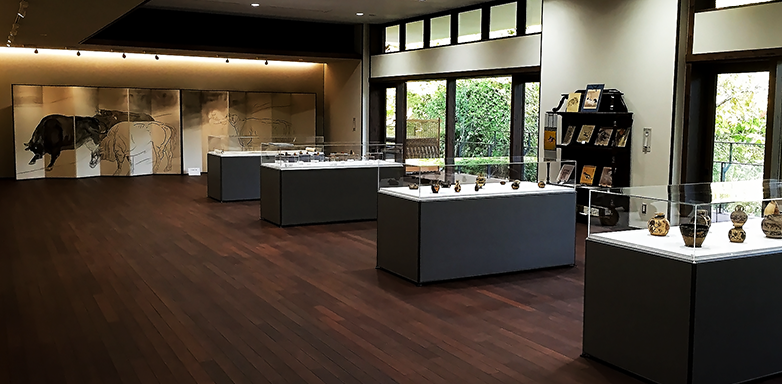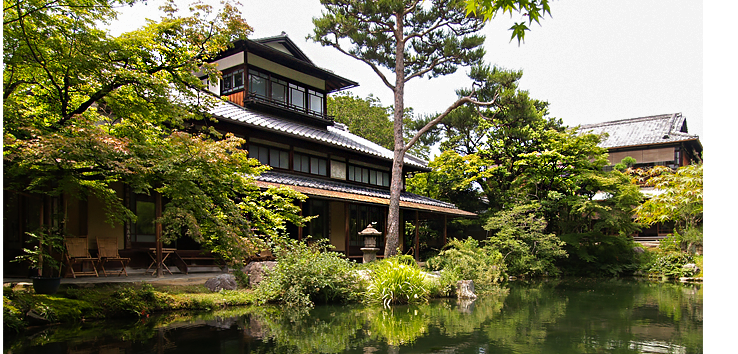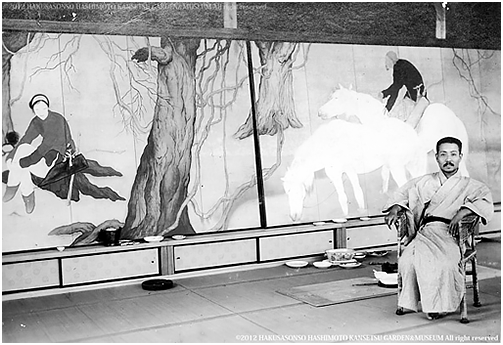
THIS NEW SPACE IN HAKUSASONSO BLENDS ART WITH
THE GARDEN
You can catch glimpses of the Higashiyama mountains - the setting for the famous Daimonji bonfire honoring the spirits of ancestors during the Obon festival - from the garden at Hakusasonso. From the second floor of the art museum, these magnificent mountains look like a large landscape painted on a folding screen. Visitors can enjoy these abundant views with beautiful cherry blossoms in the spring and colorful foliage in the autumn.


HASHIMOTO KANSETSU MUSEUM
HASHIMOTO KANSETSU MUSEUM is an art museum that displays the painting of Hashimoto Kansetsu , a Nihonga (Japanese-style paintings) arist who was a member of the Kyoto art world in the modern era , The exhibition is changed monthly and includes works such as Hashimoto Kansetsu is Nihonga paintings , drawings , and sketches , as well as antique Eastern and Western art from the museum’s collection. These exhibitions are based on regular public displays of his collection personally put on by Hashimoto Kansetsu. After Hashimoto Kansetsu is death , his family members continued this exhibition project for the preservation and maintenance of Hakusasonso. The art museum was officially opend in 1963. Afterwards , a new museum was opened in 2014 according to Hashimoto Kansetsu’s plan. It has three large and small exhibition rooms , allowing for exhibitions connected with the buildings in the garden like the studio and teahouse. It also showas works by domestic and international artists besides Hashimoto Kansetsu and carries out a wide range of activities as a base for art and culture in the Ginakuji-temple area.

HAKUSASONSO GARDEN
Hakusasonso is a garden built by Hashimoto Kansetsu , a Nihonga(Japanese-style painting) artist who was a member of the Kyoto art world in the modern era , over approximately 32years from 1913 to 1945 in an area that was previously paddy fields. The 10,000-square meter site contains buildings such as a large studio he used exclusively for large works , tea house , and personal Buddhist temple.There are also many works of stone art from the Heian to Kamakura periods. It is the largest artist residence in Japan , and most of it has been preserved as it was when the garden was constructed.The scenery in the garden changes throughout the four seasons , resembling the landscapes painted by Kansetsu. Hakusasonso garden was designated as a National Site of Scenic beauty unparalleled arsthetic sense.

HASHIMOTO KANSETSU
Hashimoto Kansetsu (1883-1945) was a Nihonga (Japanese-style painting) artist who was active in the art world of Kyoto during the modern era from the Taisho to Showa periods. He prossesses profound knowledge of ancient Japanese and Chinese classical dokuments and history, and was also knowledgeable in ancient and modern calligraphy art based on poetry. His talent was evident from childhood and after deciding to become an artist he produced “new Nanga” (the southern school of Chinese painting) and Classic-painting incorporating the styles of various schools from inside and outside Japan , which he studied by himself , based on the Shijo-school. The siries of animals he made in his last years was especially highly evaluated. He is also known for creating many gardens throughtout his life and collecting countless numbers of old works of art.
| 1883 | Born in Kobe-city , Hyogo prefecture , Japan |
| 1898 | Moved to Tokyo to become a painter |
| 1903 | Entered Takeuchi Seiho is private painting “Chikujo-kai” school in Kyoto |
| 1905 | Served in the Russo-Japanese war |
| 1913 | Won his first prize with “Chijitsu (Long Spring Day)” , which was exhibited in the 7th Bunten Exhibition. |
| 1916 | Completed and moved to Hakusasonso near Ginakakuji-temple in Kyoto Received his first special prize for ” Hanshan and Shide” , which was exhibited in the 12th Imperial academy art exhibition. |
| 1922 | Donated 360 cherry trees along the Philosopher’s path are referred to as “Kansetsu’s cherry trees” |
| 1928 | Displayed “Mulan” and “Xiaoxiang” in an exhibition of Japanese art held in Paris , France. |
| 1929 | Displayed “Black gibbon” in an exhibition of Japanese art held in Rome , Italy. |
| 1932 | Yone , the wife who supported Kansetsu , passed away. |
| 1933 | Displayed “Black gibbon” in the 14th Imperial academy art exhibition. It was then purchased by the Ministry of Education , Science and Culture. |
| 1934 | Was appointed as Imperial Househeld artist. |
| 1939 | Displayed “Sou-en (White monkey) ” at the Newyork world fair exhibition. |
| 1940 | Completed and exhibited 48 Fusuma (sliding door) paintings for Ken-ninji temple in Kyoto. |
| 1945 | Passed away at Hakusasonso - the age of 61. |
Biography
Access
- ・From West Japan Railway (JR) Kyoto station
- ・Approximate time required 50 minutes
- ・Take the Kyoto-city bus No.100 -> Get off at the “Ginkakujimae” bus stop
- -> 1 minute by walk
- ・From Hankyu railway “Shijo Kawaramachi” station
- ・Approximate time required 30 minutes
- ・Take the Kyoto-city bus No.32 -> Get off at the “Ginkakujimae” bus stop
- -> 1 minute by walk
- ・From Keihan railway “Demachiyanagi” station
- ・Approximate time required 15 minutes
- ・Take the Kyoto-city bus No.17 -> Get off at the “Ginkakujimichi” bus stop
- -> 5 minute by walk

